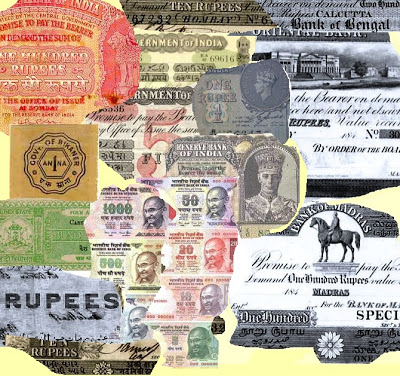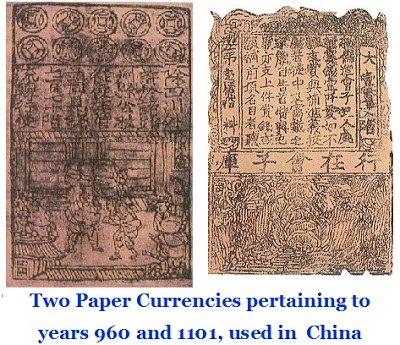
Origin and growth of Bank Notes and Currencies – 1
ORIGIN AND GROWTH OF
BANK NOTES AND CURRENCIES – 1

The birth and growth of Paper Currencies and Bank Notes stemmed from several facts spread across centuries. It will therefore be interesting to know how the Paper Currencies and Bank Notes world over came to be accepted as Money replacing the earlier form of Money that were exchanged in different stocks.
Now Money as a means of payment, consists of coins, paper money and withdrawal documents. Today, credit cards and electronic cash form an important component of the payment system. However a majority of common people prefer the use of paper currency and coins for transacting their day to day business. Especially in a country like India which has vast majority of her people living in the villages, people believe in transacting anything and everything through liquid cash which is in the form of printed notes or coins. It is true that only from the primitive system called barter i.e. exchange of goods for goods- emerged the system of payment through some form of money- -both made of Metals and Paper.
At the beginning of the bygone years say in and around 9000 BC, it was seen that the most popular form of barter was live stocks such as Ox, cows, goats , sheep etc which were exchanged. With the advent of agriculture the use of grain and other vegetable or plant products too came to be exchanged. Besides the live stocks and cattle, in and around 13000 BC, expensive shells and cowries which were widely available in the Indian Ocean and Pacific Ocean were also considered as money for transacting the business. They were considered treasured item in the civilizations of China and India from very early times. This system continued till the Europeans arrived in Asia.
In about 1500 years ago metals represented the stored value of goods exchanged as barter in place of shells and Cowries. The earliest form of money in metallic form was used in China in and around 1000 BC while in the third millennium BC in Egypt the metallic Money consisted of Gold bars. Money, one of the earliest and most significant inventions of civilization became essential to the development of trade.
When use of metals as a form of Money became prevalent they had holes in between as the coins could be chained together which made one easier to carry them for transacting the business. If we see the earlier coins issued by the Govt of India, one may find holes in the center for few reasons. It was perhaps thought that the coins will weigh less and they can be easily carried by chaining with thick thread if they had holes. From metals like Copper and Steel came the Silver, Bronze and Gold coins to act as Money. Gradually the metallic coins with some images impregnated as seals were adopted across the world as Money.
The next form of currency that was used as Money was issued in leather for a limited period but did not succeed. The idea of a using durable light-weight substance like leather as evidence of a promise to pay a bearer on demand originated during the Han Dynasty in China. It has been discovered that around the year 118 B.C when Han Dynasty ruled China, some of the banknotes in China were made from leather such as white deerskin. This period is believed to be just the starting of paper money.
This may be true because parched vellum, an animal skin treated and used as Paper to document the texts surfaced in China during the same period i.e 9th century A.D to 15th Century A.D. Numismatics are of the opinion that in India in the 13th century in the Yadav kingdom the concept of leather currency appeared to have been known. If a king were to impress his royal stamp on a piece of leather, it may pass of as Money. In one of the most infamous act an eccentric monarch called Muhammad Bin Tughlaq (1325-1350 AD), reportedly introduced leather currency in India, but like many of his other monetary reforms it did not succeed.

“All these pieces of paper are issued with as much solemnity and authority as if they were of pure gold or silver; and on every piece a variety of officials, whose duty it is, have to write their names, and to put their seals.
– Unquote ( Courtesy: http://www.computersmiths.com )













Recent Comments